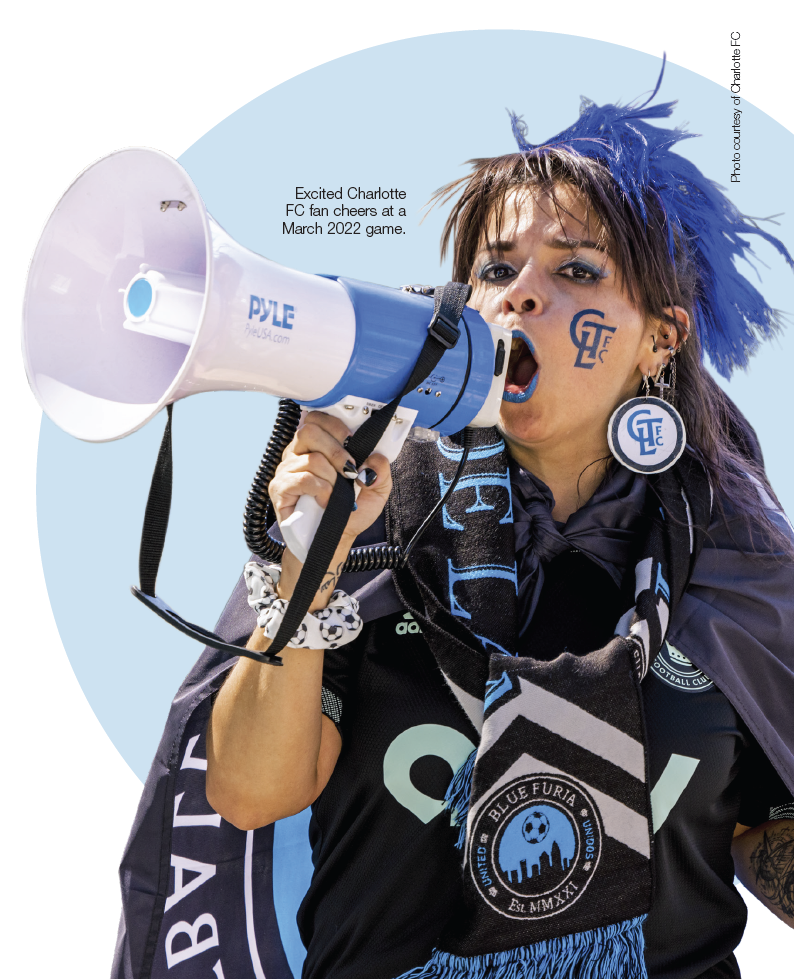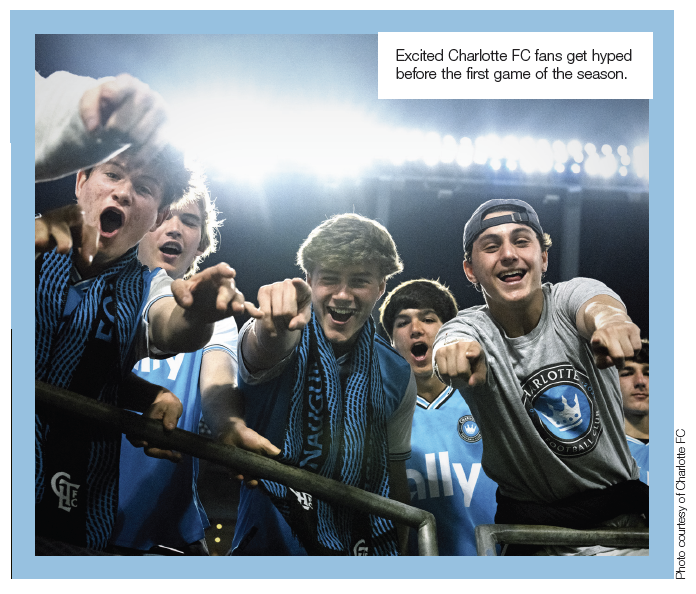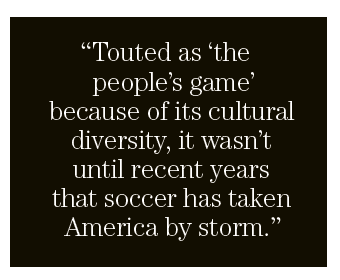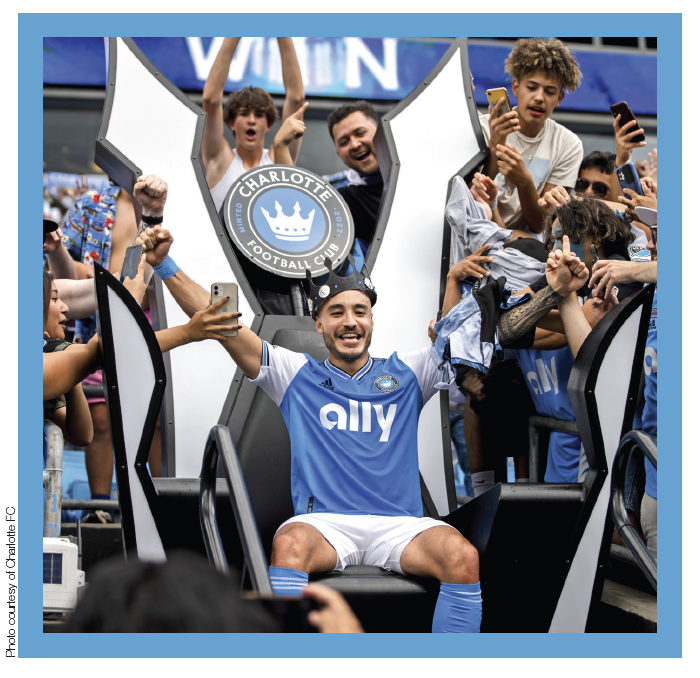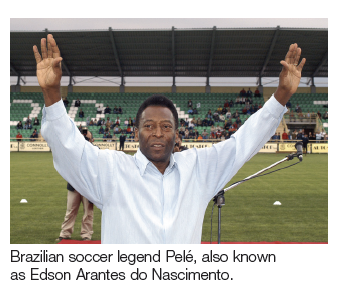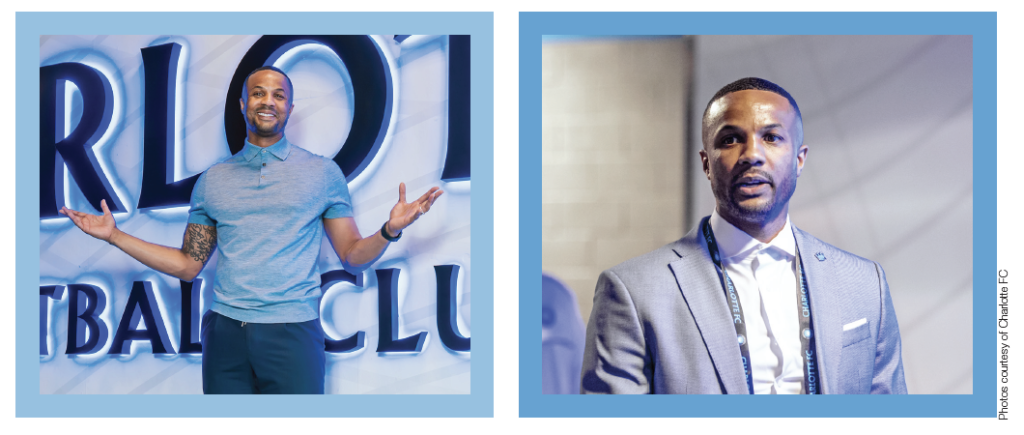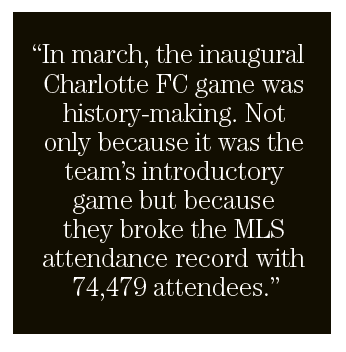By John Burton Jr.
So Charlotte, are you ready for some football, I mean soccer? Although the word “football” conjures up images of quarterbacks, running backs and offensive lines, people internationally think of “football” as two teams of 11 players running on a field, trying to kick a round ball into the other teams’ goal net — that’s “soccer” to us in America. Luckily, since last year Charlotteans have been able to enjoy professional soccer right here in the Queen City with our city’s first professional soccer team — the Charlotte FC.
When you eventually make it to a Charlotte FC game, you’ll hear the fans gleefully shouting, “Olé, Olé, Olé!”
According to soccer blogger Jibin S. Joseph, this was the refrain fans at especially exciting bullfights would shout. The chant made its way into Spanish soccer games in the early 1980s, and then fans around Europe adopted the shout. Eventually the cry circulated around the world and is now heard even at U.S. soccer matches. You’ll also hear loud and enthusiastic shouts of “Charlotte FC!” accompanied by four claps when you attend the team’s games. Internationally, most people use the word “football,” referring to soccer since what most Americans know as football isn’t a worldwide sport. Touted as “the people’s game” because of its cultural diversity, it wasn’t until recent years that soccer has taken the America by storm. Soccer received a
significant boost when the U.S. hosted the 1994 FIFA World Cup, 1999 FIFA Women’s World Cup and in 2007, when England sports icon David Beckham joined the LA Galaxy. Soccer is the fourth most popular sport in the U.S. behind American football, baseball and basketball.
Blacks in soccer
When Major League Soccer awarded billionaire David Tepper and Charlotte the professional soccer franchise in December 2019, the reception was somewhat mixed. Some Charlotte area folks were elated — others didn’t quite know what to make of it. Traditionally soccer has not been a sport Black people naturally gravitated toward, like baseball, basketball and football. Viewed like golf, tennis and swimming, soccer was often considered a boutique sport, which rarely included players. This added to the narrative that Black folks
don’t play soccer, which is not factual. The Afro-Brazilian soccer legend Pelé was as known as “the greatest of all time” by the football association FIFA, the highest governing body of association football. Pelé, also known as Edson Arantes do Nascimento, was among the most successful and popular sports figures of the 20th century. In the U.S, Black soccer history can trace its lineage back to brothers, Oliver and Fred Watson, the first known African American soccer players in the U.S. in the late 1800s. The Watsons and many other unsung Black soccer players blazed the trail for others to follow like Cobi Jones, Briana Scurry, and High Point native and National Soccer Hall of Famer, Eddie Pope.
According to Zippia.com, here’s the makeup of professional soccer players in the U.S., this year:
- White,78.0 percent
- Hispanic or Latino, 7.2 percent
- Black or African American, 6.8 percent
- Asian,3.9 percent
- Unknown,3.7 percent
- American Indian and Alaska Native, 0.4 percent
A unique NC soccer leader
Darrius Barnes, the President of Charlotte FC’s MLS Next Pro, joined the organization in 2021 as the Club’s Director of Business Operations. The Raleigh native’s storied career in soccer began at age five. MLS Next Pro is a minor league division of the Major League Soccer system. “I was in kindergarten and a buddy of mine invited me to play at recess time and the rest is history,” Barnes said. He began playing on recreational teams, then for travel and classic leagues. Usually, the only Black player on his teams, Barnes realized early that diversity would be a challenge. Still, he was not dissuaded. He took inspiration from other Black players like Eddie Pope.
“He was one of my biggest idols. He was someone who looked like me, played the same position and had the same playing profiles,” Barnes said. Barnes’ on-field prowess and perseverance paid off resulting in an athletic scholarship to Duke University. After his collegiate career, he was drafted in 2009, to play professionally with the New England Revolution. He played professionally for eight years before retiring in 2017.
Awareness and advocacy
“When I was growing up, soccer was a sport that many people didn’t know much about, including my parents. But they saw it brought me joy,” Barnes said. In his new role as president of MLS Next Pro, Barnes said he hopes to shine a spotlight on the next generation of young players, preparing them for their futures, both in soccer and in life, which includes people of color. “Soccer is still growing in black and brown communities,” he said. Because soccer is an international game, Barnes hopes his efforts will allow people to think beyond stateside games to ponder the sport’s other benefits beyond the field. “Soccer is such a global game. I think people in the United States are starting to realize that and how much of a unifier this sport can be,” he added. “It brings people from different nationalities, cultures and ethnicities together. Soccer is their common language.”
The strong sense of advocacy and inclusiveness among MLS soccer players is underappreciated. Many players, past and present, have been outspoken about causes they support. Black Players for Change is an independent nonprofit organization consisting of close to 200 Black players, coaches, and staff of MLS, working to bridge the racial equality gap that exists in society. Soccer Collective on Racial Equality’s mission is to increase the representation of Black and Brown men and women in soccer and create equitable access for all people regardless of color, ethnicity, religion and sexual orientation.
Soccer is catching on
In March, the inaugural Charlotte FC game was history-making. Not only because it was the team’s introductory game but because they broke the MLS attendance record with 74,479 attendees. In 27 seasons of MLS, there had never been a larger attendance for a single match. This was 388 attendees shy of completely packing Bank of America Stadium. “For it to be their first season, I was surprised at how crowded it was,” said Jabari Chavis, 44, who attended his first pro soccer match. “It was great to see all the people decked out in their jerseys, shirts and scarfs. I’ll definitely go back.” The attendance record sent a message to Charlotte and the rest of the nation: Soccer is thriving in the U.S.

